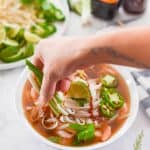
Vietnamese Shrimp Pho
Servings: 6 quarts
This recipe takes a day to prepare, but it's so worth the wait.Special Equipment Needed:
Print Recipe
- large roasting pan
- a large stock pot or slow cooker (at least 8 qt)
- fine mesh colander or chinoise
- spider or slotted spoon
- tea towel or cheesecloth
Ingredients
- 3-4 lbs bones mix of beef and pork neck bones is recommended
- 2 lbs oxtails
- 7 quarts cold water divided
- 3 bulbs of garlic sliced in half across the diameter
- 4 onions sliced in half length-wise
- 1 3 " piece of ginger sliced in half length-wise
- 5 star anise pods
- 2 4 " cinnamon sticks
- 6 whole cloves
- 2 whole allspice berries
- 1 tsp black peppercorns
- 2 tbsp fish sauce
- 1/4 cup dark brown sugar or piloncillo
- 2 tbsp kosher salt
- 1 lb large shrimp peeled and deveined (or thinly sliced top sirloin or sliced, cooked chicken breast)
- 16 oz pho noodles small or medium size
Condiments:
- mung bean sprouts
- lime wedges
- sliced jalapeño
- cilantro leaves
- thai basil leaves
- mint leaves
- sliced green onions
- fish sauce
- sriracha sauce
Instructions
- Preheat your oven to 375°F. Place the bones and oxtails into a roasting pan in a single layer and roast for 2 hours, flipping the bones once during the roasting process. Remove the pan from the oven and transfer the meat to a 8 qt (or larger) stock pot, or slow cooker.
- Place the roasting pan onto the stove. Heat the pan over medium high-heat and pour in one cup of cold water. Using a wooden spoon, scrape up any bits of stuck-on meat from the bottom of the pan. Pour the juices from the roasting pan into the cooking pot/slow cooker with the bones.
- Place the garlic, onion, and ginger into the deglazed pan, cut side down. Put the pan into your oven with the broiler set on low. Broil the aromatics for 5 minutes, or until the skin begins to char, and the flesh is slightly softened. Alternatively, you can char them over an open flame for 10 minutes: hold each over a medium flame using tongs with a rubber grip. Slowly rotate so the flame chars the entire piece. Make sure you have the exhaust fan over your stovetop running on high, and you open a window to allow the smoke to escape.
- Peel any blackened skin off of the aromatics and discard. Add the ginger, onions, and garlic to the stock pot, or slow cooker, along with the bones. Repeat the deglazing process with another cup of water if you have any bits of aromatics stuck on, and pour that liquid into the pot, as well.
- Add the wholes spices to the pot/slow cooker, followed by the remaining cold water, the fish sauce, brown sugar, and the salt. Bring the water to a boil over high heat. Reduce the heat to low, cover, and allow to simmer for 8-24 hours. Slow cooker instruction: skip bringing the soup to a boil. Allow the soup to simmer, covered, on low for a minimum of 8 hours, or, preferably, up to 24 hours.
- Place a fine mesh colander, or chinoise, over a clean soup pot. Using a spider, or a slotted spoon, transfer the larger chunks of food from the pot into the colander to strain, then discard. Rinse out your colander and return to the pot. Line the colander with a clean tea towel, or piece of cheesecloth. Carefully, pour the soup into the pot into the colander to strain away the rest of the impurities.
- Optional: Place the soup into a container and refrigerate it for 12-24 hours. During this time the fat will rise to the surface of the container and solidify. Once it has, take a large spoon and scrape off the layer of solidified fat and discard.
- When you're to serve, bring the broth to a rapid boil over high heat in a stock pot. While you're waiting for your broth to come to a boil, prepare and plate your condiments, then set aside.
- Place your shrimp, beef or cooked chicken, into your serving bowl in one layer. Avoid piling up the raw shrimp or beef slices, as it will prevent them from being cooked by the boiling soup. Allow the soup to cook the shrimp for at least three minutes.
- Meanwhile, add your thin rice noodles to the hot soup in the pot. Allow the noodles to soften slightly. Transfer the softened noodles to your bowl with a pair of tongs. Serve while the soup is still hot.
- Customize your pho with the condiments as desired.
- Any remaining pho broth can be refrigerated for later enjoyment and is also perfect for freezing. Simply pour the cooled broth into a freezer-safe storage container (or bag) and freeze for up to two months.
Notes
- An additional chilling time of 12-24 hours is needed if you decide to skim the fat from the broth.